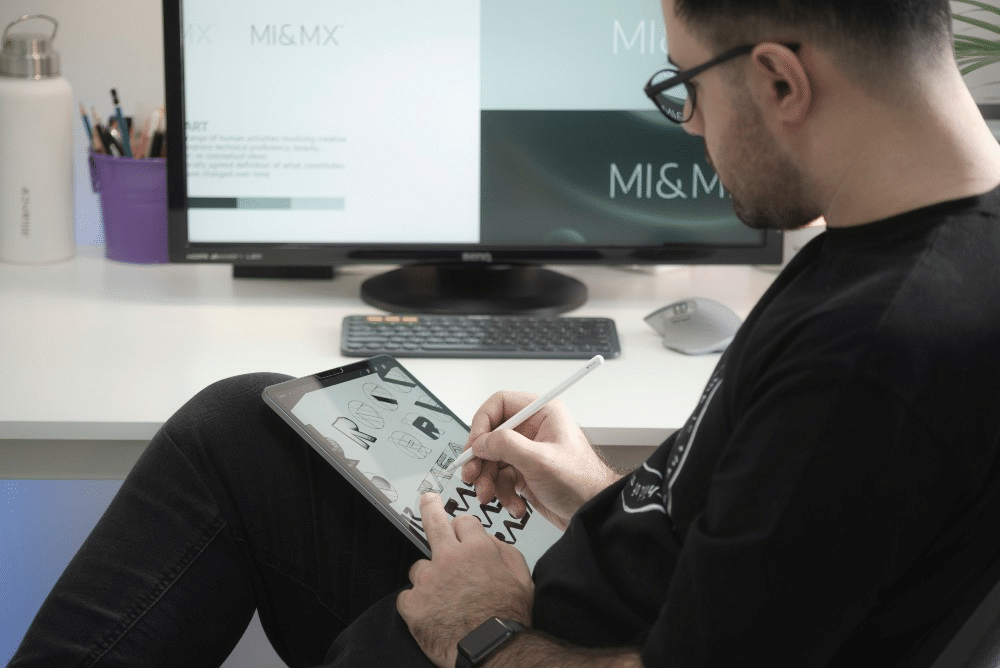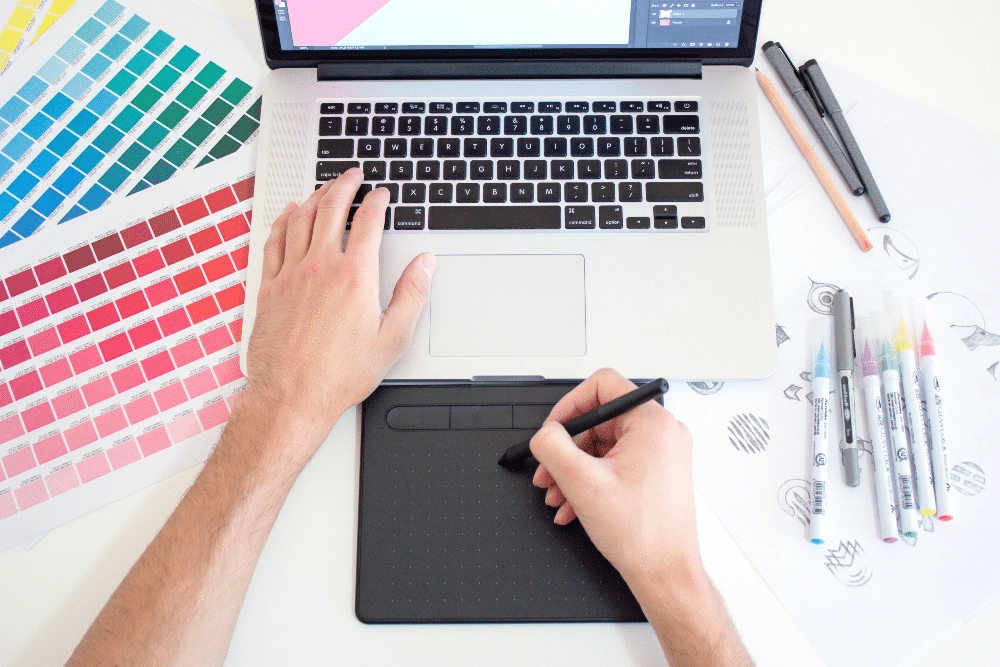Welcome to a detailed guide on Graphic Design Portfolio!
This article describes what makes a good Graphic Design Portfolio, how to make one for different levels of your career, and some do’s and don’ts.
This article lets you know which approach to use when creating your own portfolio, either a minimalist or full-screen feng-shui design, to capture your clients.
We cover the following:
- What makes a good design portfolio?
- Graphic Design portfolio for students
- Graphic Design portfolio for entry-level to mid-level job applications
- Essential tips for creating the perfect portfolio
- Things to avoid
Let’s dive in!
Introduction

Design is a creation done intentionally.
Planning and carrying out a design concept that expresses how we perceive and think about the world requires effort.
Graphic design is the art of conveying ideas visually using various tools, strategies, and methodologies.
Many modern employment categories extensively use graphic and web design professions and graphic design is now seen as a necessary work skill.
This is frequently true in the marketing, e-commerce, online, entertainment, creative, digital, and print sectors, where proficiency with graphic design tools is required.
Brands, goods, and experiences can be advanced to a worldwide level with the help of graphic editorial design.
Every independent graphic designer needs a great portfolio to build a competitive advantage.
A web portfolio for a graphic designer demonstrates your creativity, sense of style, authority, and adaptability.

But compiling screenshots of your prior work isn’t the only use for a Graphic Design Portfolio.
It entails creating a Graphic Design Portfolio website, including all the little things like selecting the best web hosting, themes, and plugins, and customizing your work for your target audience.
Building the best Graphic Design Portfolio template is increasingly necessary due to the increase in graphic design tasks.
It is crucial to be aware of everything while creating your own portfolio because it is the most efficient and appropriate approach to showing your work to potential clients.
Whether at the beginning of your profession, applying to digital design school, trying to stand out among other designers, or seeking to become an art director, you may use insightful tools to help and direct you as you maintain your design portfolio website.
We know you have grown weary of looking for the most outstanding Graphic Design Portfolio examples online.
Finally, you’ve arrived at the perfect location.
Keep reading to find out everything there is to know about making a Graphic Design Portfolio.
What makes a good Graphic Design Portfolio?

Excellent written and visual materials are essential for a solid Graphic Design Portfolio.

Written material enables you to convey ideas that images cannot, while visual content demonstrates your abilities as a Graphic Designer.
Visual Content
A solid visual graphic design element displays your most incredible work and unique brand and personality.
Branding
Successful freelancing depends on having a solid personal brand.
When someone enters your website, the very first thing they see is the layout and style.
Yes, your website’s appearance will also be taken into account.
Focus on your distinctive design style while developing your personal brand, and incorporate it into the fonts, logo, and colors of your website.
Here, showcasing your uniqueness is encouraged. Showing clients your distinctive brand and style will help you stand out.
Sample Projects
Concentrating on a few major projects that best demonstrate your abilities when selecting example projects to exhibit on your website is important.
If choosing projects is challenging for you, consider your personal brand identity.
There must be a niche or demographic that you specialize in as a Graphic Designer.
Think about concentrating on the tasks you enjoy, are good at, and for which you are frequently contacted.
If you’re starting, think about signing up for Creative Bloq or Invision to publish your design projects and participating in design competitions in your neighborhood, whether in New York, San Francisco, etc., as ways to build your portfolio.
Last but not least, remember to use excellent photographs to display your work.
Written Content
While most of a Graphic Designer’s work is visual, good communication skills make part of the packaging design.
Written content should be included when you learn how to create a Graphic Design Portfolio because:
- It enables viewers to comprehend the design processes involved in your creations.
- It facilitates website discovery by search engines.
- You get recognized as a public intellectual in your field as a result.
The following written elements should be on your digital design portfolio website:
- About page
- Case studies
- Contact details
- Blog
- Reviews or Testimonials
About Page
To find out more about a website’s design studio and site arrivals, go to the About page.
A properly written About page might help you gain access to opportunities.
Writing a page about yourself, though, might be difficult.
If you’re unsure of what to say on your about page, keep it short and simple and begin with your:
- Informational background.
- Individual and professional experience
- Academic background
- Skills
- Media and platform you leverage
- Acknowledgment and achievements
Contact Information
Including contact details on your website gives potential customers a chance to get in touch.
Include backlinks to your social media accounts and a reputable business email address.
Incorporate a call-to-action toggle as a substitute to encourage website guests to take action, such as requesting a consultation, contact, or quote or subscribing to a newsletter.
Case Studies
Include a brief essay or case study on how you enabled former clients to succeed to complement your visual content and clarify your example projects.
You can add the following details to your case studies:
- Project’s goal and purpose
- Role and length of the project
- Design strategy
- Results
Blog
Having a blog area on your portfolio website is optional, but it’s a great method to express your ideas and position yourself as a public intellectual.
Additionally to improving your search engine optimization (SEO) efforts, it gives customers a cause to revisit your website.
If you struggle with writing, remember that content doesn’t necessarily have to be blog entries.
You might include press you’ve received, such as accolades, videos, podcast appearances, and freebies like icon sets or typographies.
The last step is to distribute the content you’ve added to your website for your graphic design portfolio with your network utilizing social media marketing tools.
Syndicate your material if you’ve registered on Behance and Dribbble so those websites can also see your online portfolio.
Testimonials or Reviews
Posting and displaying your capabilities is insufficient if you lack a professional reference.
Three out of four people trust online reviews more than peer recommendations.
To obtain testimonials, get in touch with your past grateful customers and request a quick assessment of the service you rendered.
How to create a Graphic Design Portfolio to get potential clients or get hired

A strong portfolio is crucial when starting as a Graphic Designer.
Your most effective marketing weapon is a solid portfolio.
It demonstrates to potential customers the kind of job you can complete and how you can do it.
Potential employers, partners, and clients will notice you if you have a strong Graphic Design Portfolio.
The best graphic design portfolio can be created using the following suggestions:
Choose an appropriate theme
A lot of individuals initially become preoccupied with their design portfolios.
They believe they must create something extremely elaborate to wow their potential customers.
You can take it more accessible than you think.
Choose a straightforward portfolio website, like Squarespace, if you’re starting out and concentrate solely on producing quality content.
You can enhance your website with more sophisticated features made for experienced designers and agencies once you start receiving more customer queries.
Be innovative
In the world of graphic design, innovation is crucial.
Always watch for new, better methods to showcase your work.
You can do this by adding interactive features and videos to your website.
Your portfolio will have a new, attention-grabbing look as a result.
Additionally, it will help your website stand out from rivals who might not be utilizing similar components in their portfolios.
Utilize white space
Your portfolio will look cleaner thanks to the stylish and contemporary aesthetic that white space helps to generate.
White space prevents other items on the website from detracting users from their attention from the photos.
It also aids in highlighting the salient elements of each image, such as the typeface or color scheme of a logo design you produced for a customer.
Considering your audience
There are numerous approaches to creating Graphic Design Portfolios.
Images, animation, video, and even interactive components are all acceptable.
This kind of presentation aims to demonstrate your value to prospective customers.
Because of this, it ought to be limited to what you wish to do.
Additionally, it must be pertinent to the group of people you are trying to reach.
Your portfolio should contain comparable work samples if your target audience is more interested in multimedia-rich graphic design.
The same holds for every other visual design component, including websites and logos.
Value quality to quantity
Even though it seems like the perfect idea to produce as much content as possible for your portfolio, it isn’t always the case.
Instead of cluttering your portfolio with several mediocre pieces of work, it is much more imperative that everything you include is of the highest caliber.
Pick the relevant colors
Establish a theme that will run across the entire project as you develop your portfolio.
This will enhance the portfolio’s visual attractiveness while making it simpler to traverse.
People are strongly influenced by color.

Make thoughtful color selections because they will affect how people view your work.
Use pastels for primarily text-heavy tasks, like proposals, reports, or brochures, and try to use vibrant colors for those requiring more attention.
Graphic Design Portfolio for Students

You might be thinking about changing your academic future, or you might have just started a graphic design degree at your university or college.
Creating a Graphic Design Portfolio will be a crucial first step in launching your design career.
If you are building a portfolio to qualify for a university program, review all the prerequisites first.
Some schools will particularly request certain case studies or styles of work; others will let you include various designs in your design portfolio.
Animation, packaging, print, product, and logo designs are frequently requested services.
Choose a few items from initiatives you consider a shoo-in if you’re enrolled in a graphic design course.
As you progress through school, update your portfolio, including recent projects, to ensure your portfolio accurately represents your current aesthetic as a budding designer.
Spend some time looking through your projects and curate a collection of your work to present, even though you might not have many tasks from which to choose.
One’s best work is usually the best choice, whether it was produced for leisure, school, or family.
You can carefully select your best work, or your latest masterpieces, for your portfolio website as you progress through school and begin to accumulate a case-load of work.
Graphic Design Portfolio for Entry-level to Mid-level Graphic Designers

Potential clients can view your abilities, personality, and potential through your portfolio, which provides a window into your world.
It’s a collection of work (or work in progress) that shows how your creativity has grown through time.

It will change based on the level of study you’re applying it to, and both the material and format will likely change with time.
It demonstrates your versatility in terms of how you approach various tasks, topics, and methodologies and how you gather, structure, and organize your thoughts.
Instead of assigning tasks to new clients in chronological order, take into account your audience.
Your portfolio can be compared to a good novel or music piece with an impactful beginning, an engaging middle, and a punchy finale.
After graduating from college, you’ll discover that the goal of your portfolio has changed, and you’ll need to make changes to reflect a graphic design professional as you’re now trying to get clients and paid employment.
Your updated portfolio will represent this development in your career as a Graphic Designer, and the products you display there will probably differ significantly from those you created in school.
You’ll want your portfolio to stand out when competing with the world’s greatest Graphic Designers.
Your design portfolio website will require some adjustments to give it a more professional appearance now that the time is ripe to start seeking employment as a part-time or independent Graphic Designer.
If you are aware of exactly what has to be filtered into or out of your portfolio, becoming known as a reliable and competent Graphic Designer is simple.
Projects you finish while in school can be kept in the portfolio, but this is based on the assumption that they can match up well with your best works.
Are you applying for a Creative Director position?
Your portfolio should demonstrate why you’re the ideal candidate for the job.
While you should emphasize your area of specialty, it’s also crucial to show that you can work across various design genres.
A wider variety of designs makes you more appealing to potential clients, making you more valuable as an employee.
What are some of the applications you can use to build your design portfolio?

When it comes to building a Graphic Design Portfolio, there are many different approaches you can take.
One of the most important considerations is the platform, format, or template you use to showcase your work.

There are several different software applications and online services that can be used for this purpose.
Some popular options include:
- Adobe Photoshop
- InDesign
- Illustrator
- Adobe Illustrator
- Behance
- Carbonmade.
- Wix
- Squarespace
- WordPress
- Creative Cloud
- Weebly
- Etsy
- Shopify
Each of these platforms offers its own unique set of features and tools.
As a result, it’s essential to choose the one that best suits your needs and preferences.
How to Make a Graphic Design Portfolio with no experience?

You must begin working on your first projects if you want to create a Graphic Design Portfolio from scratch without any prior design experience.
You may build your first design by watching an online lesson and following it.
Sign up for a Masterclass with a reputable freelance designer and watch them do their magic; you will learn a thing or two about graphic editorial design.
To improve your design abilities, look for some freelance employment, graphic design challenges, or volunteer opportunities.
Your aim is to compile several pieces of art that you may use to build a portfolio, even if they are typically free.
Your sketches can be included as well.
Essential Tips when Creating your Portfolio

The step-by-step instruction on developing an attractive online portfolio is just the beginning of what I have to offer because it’s a lengthy and challenging process.
After learning the fundamentals of what to do, what resources might be helpful, and what to pay attention to, you might still require a few pointers.

This part will discuss some additions you may make to your website to make it more lively, suggestions for selecting the artwork, and future work with it so you can be completely prepared with all necessary knowledge.
Select versatile artworks
One of the secrets to the accomplishment of your portfolio is versatility.
It’s your moment to shine if you work in various aspects of graphic design or enjoy trying out new looks.
A wide range of art directions in your portfolio will allow you to express yourself and provide your audience and clients a chance to see how skilled a Graphic Designer you are.
Though it would be difficult to concentrate on your projects if your artwork appeared visually crowded, you can think about arranging it somehow.
Outcomes of your Graphic Design work
Have you personally undertaken graphic design endeavors that have achieved great success?
The best place to discuss it is in your online portfolio.
For these kinds of works, you can include a study case where you can discuss the project’s success and perhaps add a few words on the creative process.
If you have, you can list any notable clients you’ve worked with in a specific section of your website.
It might serve as a cue for specific clients to give you some thought.
Be creative
Naturally, a portfolio is a perfect area for you to overflow with your creative ideas.
Bright flashes, intriguing page-flipping patterns, looping video animation, and a visually appealing home page are options here.
For your portfolio site, it’s crucial to pick a pleasing backdrop, colors, and font that blend to form a cohesive whole that complements your taste.
Making your branding portfolio design appealing and exceptional is essential because it is the first thing the audience notices.
Update your design portfolio as necessary
Since trends are continuously shifting, as time passes, you develop your design abilities, learn new information, and learn about new areas of graphic design.
Because of this, something that would have garnered interest a year ago might be outdated now.
The online portfolio must be updated frequently for you and your followers to see your professional development.
Your art gallery needs to be updated.
For a Graphic Designer to succeed more, it is a necessary component.
Things to avoid when showcasing your design work

A Graphic Design Portfolio can be considered similar to a resume or a cover letter.
It showcases your accomplishments and experience that you can use to convince potential employers of your skill set.
It would help if you handled it with the same caution you would like a resume.
Make it as professional and high-quality as possible, and if something seems off, don’t hesitate to approach your designer buddies for assistance.
It would be best if you stayed away from the following when developing your Graphic Design Portfolio.
Unprofessional design
A professional appearance should be maintained throughout your portfolio.
Don’t let amateurish typefaces, colors, or other design elements prevent people from recognizing the excellent caliber of your work.
Excessive text
If your project requires a lot of text, you’re probably not paying enough attention to the design.
Text is crucial, but you can’t allow it to dominate your design. Increase your visual attention.
Lacking contact information
Don’t overlook including your business name and contact information on the first or last page of your portfolio.
This is crucial if you’re applying for jobs and want potential employers to be able to contact you quickly.
Too many projects
Not all projects you’ve previously worked on must be represented in your portfolio.
Choose only the best or the accomplishments you are most proud of.
Free fonts
Due to its low cost and capacity to communicate a certain message or vibe, employing free fonts might be alluring.
Free typefaces, however, can not always match your expert design.
Additionally, a lot of them are of poor quality and lack characteristics.
You might even face legal action if you utilize free fonts for work-related purposes.
Reproducing someone else’s creation
Be careful not to copy famous designers’ previous creations.
The worst thing you could do to your portfolio is this since it gives potential employers no indication of your creative prowess.
In addition, plagiarism is a legal offense.
Having a wide range of skills
To gain more experience, it can be tempting to try designing every component of a project.
However, this will produce disorganized outcomes because each step could be hurried or performed subpar.
Focus on completing only one portion of a project at a time.
Instead of attempting to accomplish several things at once, this will help you develop your competence in doing one thing.
Conclusion

For a good reason, a Graphic Design Portfolio is required in the industry.
It serves as both your resume and business card.
It’s a condensed selection of your finest work accompanied by some background details that explain how and why you produced it.
Whether you’re looking for freelance work or full-time employment, it’s a living document that displays your abilities and expertise to prospective employers and clients.

There are many ways to display your work in a portfolio, from straightforward solutions like starting a website or blog to more complex choices like developing specially produced booklets or magazines.
To develop a portfolio that will help you, you must first grasp its goal, regardless of the structure you choose to help you meet your professional goals.
Frequently Asked Questions

What is a Graphic Design Portfolio?
A Graphic Design Portfolio is a collection of a designer’s best work.
It showcases design skills and style, as well as attracts new clients.
A well-curated portfolio will highlight the designer’s unique strengths, and give potential clients a sense of what it would be like to work with them.
What does a Graphic Design Portfolio look like?
A good portfolio contains a mix of digital and print work, as well as some examples of branding, packaging, and web design.
The best portfolios are those that are constantly updated with new work, as this shows that the designer is keeping up with trends and evolving their skills.
How do you start a Graphic Design Portfolio for beginners?
First, choose your best work.
Include old and new projects, and embrace your range.
Create an online portfolio that is easy to navigate and includes high-quality images.
Also, include a link to your portfolio on your business card and social media profiles.
Update your portfolio by regularly adding new projects.
How do I make a Graphic Design Portfolio without clients?
One option is to create mockups for fictional businesses or products.
Another is to design freebies or resources that other designers can use.
Enroll in design contests or collaborate with other creatives on projects.
You can also contact friends, family, and acquaintances who might be interested in seeing your work.
What size should a Graphic Design Portfolio be?
When putting together a Graphic Design Portfolio, size does matter.
A good rule of thumb is to aim for around 20 to 30 pages, which should give you enough space to showcase a variety of your best work without overwhelming the viewer.
How many pieces should be in a Graphic Design Portfolio?
While it’s important to have a strong body of work, you don’t need to go overboard.
A portfolio that contains too much work can actually be off-putting.
Your goal is to showcase your diversity and range as a designer, while also being selective and strategic about the pieces you include.
What to put in a Graphic Design Portfolio?
The ideal way to compile all of your finest graphic design work is in your portfolio.
To make it easier for a possible client to contact you, you might also include information about your background as a designer, your social network handles, and your email address.









